It’s reasonable to say that televisions have gone a long way since their inception. Bluetooth is one of the most recent technologies to be implemented into televisions, allowing you to link your TV to your phones and tablets wirelessly! Our lifestyles are continuously shifting as technology advances to our benefit, and there is no doubt that it is for the better. With the advancement, it has quite become easy to select the best smart tv with Bluetooth.
Best Smart tv with Bluetooth is another example of how technology and our way of life are always improving. They let us link our cellphones to our televisions and see content straight on the screen of the television.
When buying a new television, many people neglect if it has Bluetooth capabilities. There are good reasons why not all smart TVs come with Bluetooth. For instance, when smart TVs first became popular, the Bluetooth feature was only available on a few high-end models.
As a result, unless you had a lot of money to spend on a Smart TV (regardless of brand), you’d probably end up with one that didn’t have Bluetooth. As a result, older Smart TV models lack built-in Bluetooth capabilities. In addition, some low-end models from brands with low-end smart TV lines may not contain the Bluetooth feature in these low-end TVs, aside from older smart TV models.
Smart TVs are undeniably useful. They make it simple to link your other devices to your television and much more. Despite the fact that not many Smart TVs have Bluetooth capabilities, there are a number of fantastic TV options with Bluetooth capability from various manufacturers that employ smart TVs. We’ve compiled a selection of the best smart TV with Bluetooth that will take your visual and auditory entertainment to new heights.
Buying Guide on best smart tv with Bluetooth:
In this, we are going to explain different versions of Bluetooth with many more things.
Versions Of Bluetooth
Since the release of version 1.0 in 1999, Bluetooth has developed over a twenty-year period. It was designed to replace cables among devices and peripherals and to provide a high-throughput data connection.
Modern electronics, on the other hand, have shrunk dramatically in size. Since then, the focus of such handheld devices has changed away from pure data throughput toward battery saving.
From version 1.0 through 3.0, the Bluetooth standard shifted its priority to enhancing range and data throughput, before committing to a course correction towards power efficiency with Bluetooth Low Energy in versions 4.0 and later. Let’s take a deeper look at the evolution of the wireless communication protocol throughout time.
Bluetooth 1.0
Although Bluetooth was first introduced in 1998, it wasn’t until 1999 that the first professional Bluetooth device was released. The first versions of Bluetooth, notably 1.0 and 1.0B, had a number of issues, including a loss of privacy and product interoperability.
Bluetooth 1.1 addressed some of these glaring flaws, but the technology didn’t become feasible until Bluetooth 1.2, which increased transmission speeds to 721Kbps while also allowing for speedier connection finding.
Bluetooth 2.0
The very next major Bluetooth version addressed speed, security, and range, as well as rendering the protocol more user-friendly. Bluetooth 2.0 increased the protocol’s digital signal techniques, even more, allowing data-heavy audio applications to use Enhanced Data Rate (EDR).
The total data transfer speeds were increased to 2.1Mbps in version 2.0, and 3Mbps in Bluetooth 2.1. The maximum range was also expanded from 10 to 100 meters, and numerous simultaneous connections with the PAN were made possible. Bluetooth 2.1, on the other hand, added features like Sniff Substrating and a simpler pairing process.
Bluetooth 3.0
While Bluetooth 2.1 brought EDR, which increased data throughput to 3Mbps, Bluetooth 3.0 introduced High-Speed mode, which allowed the Bluetooth protocol to use existing Wi-Fi infrastructure to achieve theoretical speeds in excess of 24Mbps.
On paper, colocating the existing 802.11 infrastructure on newer devices to speed up Bluetooth devices sounds wonderful, but it also results in significant power demand on linked Bluetooth peripherals. Most customers and device makers favor the older Bluetooth 2.1 EDR standard over the newer and speedier 3.0 update due to the considerable reduction in battery life.
Bluetooth 4.0
Considering the unpopularity of the prior iteration’s power usage, Bluetooth 4.0 was a complete course reversal. As a result, the Bluetooth SIG designed a new power-saving Bluetooth Low Energy mode known as Bluetooth Smart. It had all of the characteristics of Bluetooth Classic, plus the ability to run on coin-cell devices.
Then came Bluetooth 4.1, which was designed to work with the time’s LTE mobile networks. The whole potential of BLE was unleashed with the release of Bluetooth 4.2, which included support for various Internet of Things-friendly technologies (IoT). To play nicely with the smart objects boom at the time, this featured various security enhancements as well as IoT-focused networking and handshake capabilities.
Bluetooth 5.0
The current-gen generation of the wireless protocol, dubbed Bluetooth 5, was designed to improve the IoT features offered by its predecessor. The majority of the enhancements are aimed at enhancing data transfer speeds and range for BLE devices.
In wireless communication, Bluetooth 5 makes ingenious use of the inverse relationship between data transmission speed and range. Low-bandwidth BLE devices, such as headphones, can now achieve higher bandwidth, while industrial and home automation sensors that don’t need to transmit large amounts of data can trade speed for range. Low-speed BLE devices can now reach distances of up to 240 meters.
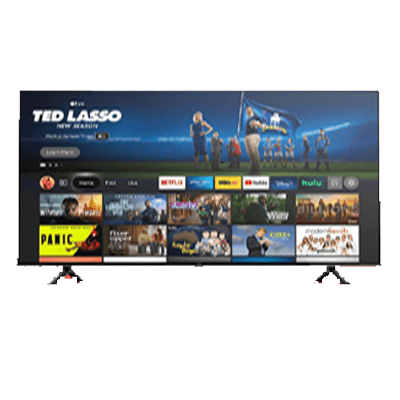
Reasons to Buy
Reasons to Avoid
A full-fledged Amazon TV designed to be the centerpiece of a living room connected to Alexa. The Amazon Fire TV 4 Series is a 4K TV that provides an Alexa-centric smart platform for people on a tight budget, and in most cases works on schedule.
This isn’t the only Amazon TV available today, but it’s the most affordable. If that’s what you’re looking for, this may be a good choice for you. But if you’re upgrading to 4K for the first time, the 4Series is a reliable TV that looks great whether you’re streaming movies, watching cable TV, or occasionally gamers.
Unsurprisingly, this low-cost TV lacks the cutting-edge functionality seen on elevated TVs, thus A/V fans and professional gamers are constrained by the 4 Model hardware. Extreme caution is required.. The 4 series has a single HDMI 2.1 (HDMI 4) connector, although the hardware is only capable of 4K / 60Hz.
The HDMI 2.1 input on the TV also enables eARC. This allows users to route Dolby TrueHD and Dolby Digital Plus audio signals directly to the receiver or soundbar, as long as the selected device also supports eARC. However, keep in mind that the TV itself does not natively decode Atmos.
Overall, it’s a pretty decent television with a standard viewing angle, subpar gradient processor, and slow reaction times. Overall, the Amazon Fire TV 4 Series is outstanding television. Vision might be a challenge in bright settings, therefore this is ideal for gloomy spaces.
Appropriate for viewing movies and TV shows on streaming media apps. However, because it is sluggish to respond, does not have enough brightness to bring out small highlights, and does not support a broad color gamut, it is rarely used in HDR, making it less ideal for watching cricket or playing online games.
Also Read: Best TV for College Dorm

Reasons to Buy
Reasons to Avoid
The Vizio V Series 2021 is a great starter 4k television. It lacks supplementary capabilities like HDMI 2.1 inputs and variable refresh rate (VRR) capability. It has a VA-type screen with deep blacks due to its high natural contrast ratio, however, it lacks a shading capability to enhance it.
Unfortunately, it has even narrower viewing angles than other VA-type TVs, so the image seems to fade out as quickly as one moves off-center. Although it handles reflections effectively, it does not produce enough light to combat glare in a brightly-lit environment.
It has poor viewing angles, far worse than most VA-type TVs, so the image washes out soon as you go out from the center. Despite having adequate mirrored image management, it does not grow bright enough to battle glare in a well-lit environment. Finally, it includes voice control, which is a new feature from Vizio.
However, unlike on a few different operating systems, you cannot install additional programs on the SmartCast device. Good for watching Documentaries and sports, but not for observing large regions owing to the restricted viewing angle. Unfortunately, HDR material is not bright and does not have a large color gamut, making it unsuitable for Hdr.
The Vizio V Series 2021 is suitable for viewing television programming. Although it does not provide much light, it has decent reflection management if used in a room with a few lights. Regrettably, it has restricted viewing ranges, so the image seems wrong from the side, and there are some upscaling errors with 720p material, similar to what you’d see on cable boxes.
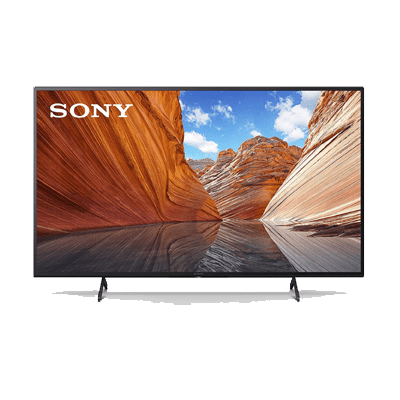
Reasons to Buy
Reasons to Avoid
The Sony X80J misses several of the capabilities seen on elevated TVs, yet it performs admirably on low-end IPS models. ADS displays with such a low dynamic range have a low contrast ratio, which causes blacks to appear grey in dark spaces and lacks localized fading to boost the black level.
That is, it has a broad viewing angle as well as a reasonable brightness. In a decently light setting, reflection is not even a problem. Notwithstanding HDR content’s color range spectrum, it lacks sufficient luminance to pull out the highlights, limiting the entire HDR impression. The gaming function is straightforward.
It has nice broad viewing angles and gets rather bright, so glare won’t be an issue in well-lit settings. While it offers a broad color reproduction for HDR video, it just does not get bright enough to bring out highlights in HDR, limiting the entire HDR experience.
It lacks variable refresh rate and Auto Reduced Latency Mode, and its HDMI connections are limited to HDMI 2.0 capacity, but hardcore gamers will appreciate its rapid reaction time and low input latency. It, like other Sony TVs from 2021, includes Chromecast, which substitutes for Android TV.
The Sony X80J is suitable for multipurpose use. It looks best in light environments and has viewing angles, which are ideal for larger seating groupings.
However, it is unsuitable for watching Netflix or playing in darkness, and its HDR functionality is mediocre due to poor contrast and the lack of a local dimming function to improve dark room performance. It also lacks modern gaming capabilities such as higher refresh rate innovation to avoid image distortion, and its refreshing rate is restricted to 60Hz.
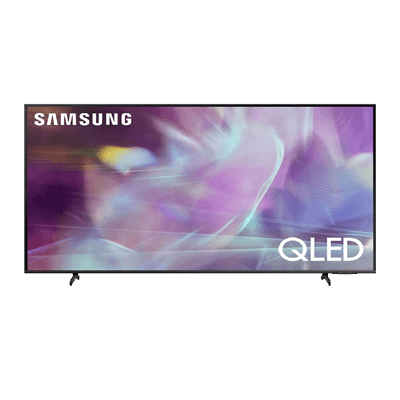
Reasons to Buy
Reasons to Avoid
Q60 A 50 Samsung “HDR 4K UHD Smart QLED TV in class. This television has a 50-inch screen “Quantum Dot LED panel with Movement innovations to enhance incredibly quickly pictures and eliminate fading electronically Increases. It is HDR10, HDR10 Plus, and HLG HDR appropriate, and it enables larger color information for suitable media as well as other gadgets for sharper pictures.
By eliminating image distortion and blurring, the automated low bandwidth mode improves the gameplay experience. The Q60 A includes WiFi and Ethernet connection for accessing your favorite apps and internet-based entertainment, as well as sharing content and display reflection with other smart devices such as smartphones.
Overall, the Samsung Q60A is good television. It gives excellent vision in bright settings, making it ideal for viewing TV shows or sports. However, because of the somewhat restricted viewing angles, it is not ideal for watching with a large group in a broad seating configuration.
It offers extremely minimal input latency for gameplay and PC monitor use, however, its 60Hz refresh rate, slightly poor reaction time, and unavailability of higher refresh rate capability may disappoint some users. Unfortunately, although having a superb contrast and color spectrum, it lacks local dimming and does not reach bright enough to provide a real HDR cinematic experience.
It uses a somewhat simplified version of Samsung’s proprietary Tizen OS smart interface, with fewer animations in general. However, it is still quite simple to use and includes a large range of streaming apps. Unfortunately, it has poor viewing angles, making it unsuitable for a large seating arrangement, and its HDR compatibility is restricted since it lacks a local dimming capability and has a low color reproduction when playing HDR material.
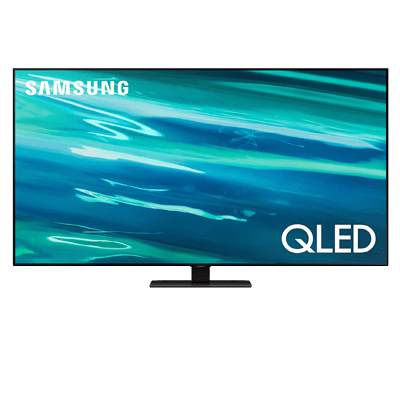
Reasons to Buy
Reasons to Avoid
The Samsung Q80/Q80A QLED is a mid-tier LED television. It will take the place of the famous Samsung Q80/Q80T QLED in 2020. However, it is no longer one of Samsung’s greatest TVs since it is positioned underneath the Nova QLED devices in the company’s 2021 portfolio.
It’s also distinct from previous Samsung TVs in that it employs an IPS-like panel with broad viewing angles at the expense of a poor dynamic range. It features a shading option to enhance darkened room efficiency, although it operates poorly and is not recommended for usage in darkened rooms.
It has Tizen OS as its smart platform, which is simple to use and has a plethora of apps accessible for downloading. It also boasts several of Samsung’s entertainment features, including as HDMI 2.1 bandwidth, variable refresh rate capability, and a 120Hz display. It also offers a fast reaction time for smooth movement, a minimal interface lag, and VRR compatibility to prevent image distortion.
Unfortunately, it isn’t a suitable choice for darkroom gaming because its IPS-like screen has a poor contrast ratio, making blacks appear gray. The Samsung Q80A is an excellent television for the majority of applications. It’s ideal for watching Films and athletics because of its broad angle of view, which makes it ideal for large seating spaces.
In a well-lit environment, it also gets strong enough to combat glare. It supports variable refresh rates and HDMI 2.1 capacity for elevated gaming, making it suitable for SDR or HDR gaming. Nevertheless, because of its poor dynamic range and inadequate local dimming, it does not function well in low-light environments. It’s also only suitable for watching Netflix, and the blossoming surrounding bright things are caused by the low-key lighting.
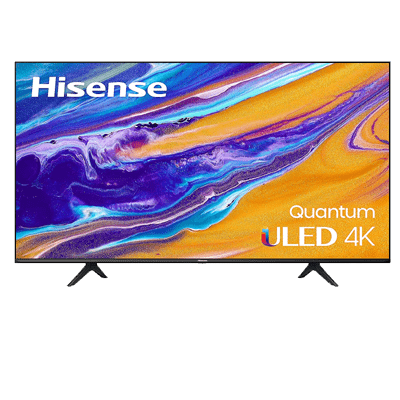
Reasons to Buy
Reasons to Avoid
Hisense It’s a low-cost model with higher photo quality than most of the other reduced TVs, and it competes with more costly alternatives, but it’s lacking in added functions. It boasts a VA display that operates well throughout dark and bright environments, displaying deep blacks for a wonderful darkened room visual experience and getting bright enough to combat glare in bright environments.
It includes Google Tv just like its constructed intelligent interface, which offers a plethora of apps accessible for downloading but takes some getting used to. It offers either Dolby Atmos or HDR10+, allowing it to broadcast your best ones regardless of format.
The Hisense U6G is an excellent television for the majority of applications. It’s ideal for watching soccer or Television programs in a brightly lit room since it becomes bright enough to combat glare, but it’s not ideal for large seating plan due to its limited angle of view, which makes the image seem faded out of the edges.
Because it shows deep blacks, it’s ideal for watching movies in a dark setting, but little sparkles don’t stand out in HDR. It’s also a good gaming TV, with little input latency and a fast response time for fluid movement management.
It does not, however, accommodate HDMI 2.1 bandwidth or variable frame rate technologies, which is frustrating if you own an Xbox or a PlayStation 5. It’s also ideal for shadowy gaming since it produces deep blacks, and the shading option boosts contrast. It does not, however, offer any sophisticated gaming capabilities, such as HDMI 2.1 capacity or variable frame rate technologies.
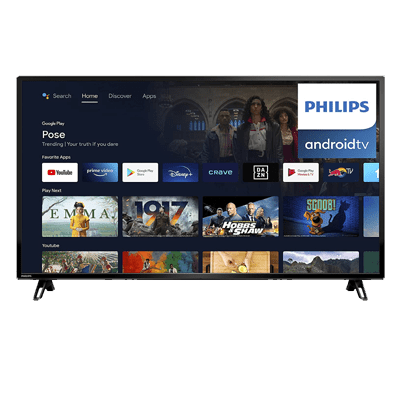
Reasons to Buy
Reasons to Avoid
The Philips 50PFL5766 excels in color reproduction thanks to Dolby Vision, HDR 10, and SDR content. There are a few wins and failures when it comes to HDR 10+ content. The skin tones appear to be fairly true, which is fantastic.
The settings menu is unlike anything you’ve seen on Android before, and it can take some getting used to. The settings, on the other hand, are simple to explore, and several complex options have been streamlined to make them more accessible to first-time TV viewers. The TV’s audio output is satisfactory.
Depending on the game you’re playing, the TV’s gaming performance is hit or miss. If you want a TV that prioritises video consumption from OTT services and set-top boxes, this is a good option. The Philips 50PFL5766 sports an IPS panel, which is the most crucial feature. The display features a 4K resolution and HDR 10, Dolby Vision, and Dolby Atmos capabilities. The TV operates on the Android TV UI and has a max brightness of 400 nits.
The panel’s performance for ingesting both HDR and SDR video is excellent, and the information is readily visible even in strongly illuminated environments. This TV’s SDR performance is excellent. The web slinger’s outfit appears to be the proper type of sumptuous blue and red in Spider-Man Homecoming on Netflix. The sequence in which he scales the Washington Monument is shot in a brightly lighted environment with a lot of brilliant colors.
We live in a time when remote controls have a minimalist appearance. Remote controls are minimally designed on devices like the Fire TV Stick (review) and Mi TVs. Volume, playback, and home are all easily accessible on the Philips 50PFL5766; however, I wish the top third of the screen was replaced with a number pad to make it easier for me to navigate the TV.
The remote control’s design is subjective, therefore this may be a design that appeals to you more. The mic and a dedicated Google Assistant button are also located on the remote control. Finally, let’s discuss the TV’s construction and design. On three sides, the bezels are relatively thin, with the thickest bezel at the bottom – very usual.
Also Read: Best Smart TV for Google Home
Conclusion
We have given you the best guide about the best smart tv with Bluetooth. Purchasing anything in today’s world is no laughing matter. We expect services and products to be worth whatever money you spend on them, regardless of how much money you spend. We are, after all, spending our hard-earned money on them.
This list was compiled with the most often requested features in televisions in mind. What works for one person may not work for another, so make sure you consider all of the important factors before making a purchase. Always choose a television that has multiple connectivity options. This ensures that you will not have to wait for your entertainment due to a lack of connectivity in one area.
